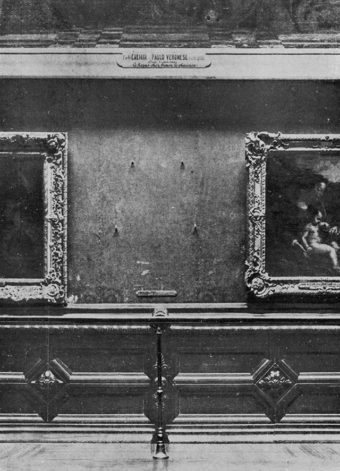 Leonardo da Vinci started work on the Mona Lisa around 1503, thought to be a commissioned painting of Lisa Gherardini, the third wife of silk merchant Freancesco del Giocondo. As to why da Vinci never delivered it, it has been speculated that he received a much more lucrative commission shortly thereafter and thus abandoned the painting at the time. Another hypothesis is that he perhaps made two versions of the painting, keeping one and delivering the other. Whatever the case, da Vinci continued working on the Mona Lisa (“Mona” more or less meaning “Madam”) up to around 1517. While today it is generally considered the most famous painting in the world, it wasn’t until French art critics began holding it up as a model of Renaissance painting techniques in the mid-19th century that it started to gain traction as anything but one of many great works by da Vinci. In fact, in the 18th century, King Louis XV actually unceremoniously had the painting removed from its place of prominence at Versailles and placed out of the way in the keeper of the royal buildings’ office.
Leonardo da Vinci started work on the Mona Lisa around 1503, thought to be a commissioned painting of Lisa Gherardini, the third wife of silk merchant Freancesco del Giocondo. As to why da Vinci never delivered it, it has been speculated that he received a much more lucrative commission shortly thereafter and thus abandoned the painting at the time. Another hypothesis is that he perhaps made two versions of the painting, keeping one and delivering the other. Whatever the case, da Vinci continued working on the Mona Lisa (“Mona” more or less meaning “Madam”) up to around 1517. While today it is generally considered the most famous painting in the world, it wasn’t until French art critics began holding it up as a model of Renaissance painting techniques in the mid-19th century that it started to gain traction as anything but one of many great works by da Vinci. In fact, in the 18th century, King Louis XV actually unceremoniously had the painting removed from its place of prominence at Versailles and placed out of the way in the keeper of the royal buildings’ office.
By the late 19th century, however, the Mona Lisa had achieved a level of significant fame among art enthusiasts of the world, but to the wider general public it was still little known. This all changed, however, when the painting was stolen in 1911. Soon after, artist Pablo Picasso was arrested for the theft.
So was Picasso actually involved and how did this theft result in the Mona Lisa becoming the most famous painting in the world?
The story today begins on Tuesday, August 22, 1911. That morning, French artist Louis Béroud arrived at the Louvre with the intention of painting a copy of the Mona Lisa. The Louvre was happy to entertain artists in this way, so long as the copies of any work are not made the same size as the original.
Unfortunately for Béroud, when he entered the Salon Carré, there was an empty space where the Mona Lisa should have hung. Béroud queried a nearby security guard asking to know where the painting was. The guard assumed it must have been removed by the photography department, as they frequently did this without telling anyone.
Not satisfied with that explanation, Béroud demanded the guard find out where the painting was and when it would be put back. However, after extensive searching, the guard was unable to locate anyone who knew anything about what had happened to the painting. Soon after, the Louvre was closed while staff and French police combed over 1,000 rooms in the sprawling museum. But to no avail- the Mona Lisa was gone.
In the aftermath, law enforcement all over France scrambled to secure the borders in case the thief tried to leave the country with the painting, searching every piece of luggage heading out of the country. Ships that had sailed after the theft, but before search efforts were started, were subsequently searched when they reached their destination.
The authorities also interviewed and investigated every single employee at the Louvre. After all, the painting had been there on Sunday, but was not on Tuesday. The only people who should have had access to the building on Monday were employees working that day. And even if it wasn’t an employee, surely with so many people in the building, someone must have seen something. But this avenue of investigation also went nowhere.
The press had a field day. French newspapers began a bidding war to see who could offer the largest reward for information leading to the painting’s safe return, such as the Paris-Journal which offered 50,000 francs (about €198,000 Euros or $220,000 today).
When the museum finally reopened in early September, visitors surged in just to see the place where the Mona Lisa had hung. Budding author Franz Kafka himself would go visit the Louvre to look at the empty section of the wall, noting in his journal, “the excitement and the knots of people, as if the Mona Lisa had just been stolen.”
Yet, despite everything, there were no solid leads and the trail was completely cold.
That is, until police were tipped off on the whereabouts of some other items that had been stolen from the Louvre.
This brings us to Pablo Picasso.
When Picasso made his way to Paris in 1900, among many other artistically minded friends he made was poet Guillaume Apollinaire. Apollinaire, in turn, had a secretary by the name of Géry Pieret. Knowing Picasso’s love of the 3rd and 4th century Iberian sculptures then on display at the Louvre, Pieret decided to simply go to the Louvre and take a couple of them. As it turns out, given the low density of security guards at the facility relative to its immense size, the theft apparently wasn’t difficult.
When Pieret presented the statues to Picasso, he loved them, with Apollinaire and Picasso ultimately paying Pieret 100 francs (about $440 today) for the stolen items. Picasso would actually go on to use the face of one of the statues in his famed 1907 masterpiece Les Demoiselles d’Avignon.
Moving on to 1911, Pieret found himself broke and decided to go steal more things from the Louvre to, in turn, sell. When Apollinaire found out, he kicked him out of his apartment, funny enough, on the day the Mona Lisa was stolen.
With items stolen from the Louvre now being front page news, Apollinaire and Picasso had a bit of an issue that they’d not exactly kept their possession of the stolen statues a secret, with Apollinaire actually displaying one on his mantelpiece for some time, observed by countless guests, including some journalists. It was only a matter of time before the authorities came calling.
Things got worse when, perhaps just to get revenge or to earn money from the paper if he revealed the information, Pieret informed the Paris-Journal that he knew where a couple other stolen items from the Louvre rested.
Needless to say, at this point Apollinaire and Picasso were in a bit of a panic. As Picasso’s long time mistress Fernande Olivier notes,
I can see them both: contrite children, stunned by fear and making plans to flee the country. They decided to get rid of the compromising objects immediately. Finally, they had made up their minds to go out that night and throw the suitcase containing the sculptures into the Seine—they left on foot about midnight, carrying the suitcases. They returned at two in the morning, absolutely dog-tired. They still had the suitcases, and its contents. They had wandered up and down, unable to deliver themselves of their parcel. They thought they were being followed. Their imaginations dreamed up a thousand possible occurrences, each more fantastic than the last.
Unable to bring themselves to dispose of these particular pieces of history, instead Apollinaire decided to give them to the editor of the Paris-Journal, Andre Salmon. Despite a condition of giving them back being that editor was to keep a secret his knowledge of who had possessed them, when the police grilled Salmon, he spilled the beans.
Apollinaire was promptly arrested and became prime suspect #1 for the theft of the Mona Lisa. Not long after this, Picasso was implicated by Apollinaire and in turn brought in by the police, with his apartment thoroughly searched for the missing painting. As the two were being held, newspapers had a field day about the supposed gang of radical artists led by Picasso and Apollinaire who were running an international group of art thieves on the side.
On September 8th, the two men appeared before Judge Henri Drioux. Both would devolve into hysterics, telling the judge stories that conflicted with things they’d said even moments before. At one point Picasso became so desperate he pulled a Peter, randomly proclaiming to the judge that he didn’t even know Apollinaire, despite that it was well known they were close friends.
Of this statement, decades later Picasso would state in an interview, “When the judge asked me: ‘Do you know this gentleman?’…I answered: ‘I have never seen this man.’…I saw Guillaume’s expression change. The blood ebbed from his face. I am still ashamed.”
Both men at various points broke down and wept, begging the court’s forgiveness. Ultimately the judge had seen enough, and correctly surmised that the pair had had nothing to do with the theft of the Mona Lisa and knew nothing about who had stolen it. While they had technically knowingly purchased and kept stolen goods, he let them off and they were released 4 days later, on September 12th.
Over the following two years, Louvre officials gave up hope of the Mona Lisa’s return and after briefly hanging a replica of the painting, replaced it with Baldassare Castiglione by Raphael.
During this span, reports still occasionally filtered in that the painting had been sighted or was being offered for sale, but none of them panned out. It wasn’t until November of 1913 that the story picks up. It was then that art dealer Alfredo Geri of Florence, Italy received a letter from a man identifying himself as “Leonard”.
Leonard claimed to have the Mona Lisa in his possession and wanted to meet to hand it over. After an exchange of letters, Geri involved Giovanni Poggi of the Uffizi Gallery in Florence. As to why, Poggi had detailed photographs of the real Mona Lisa which, most importantly, showed the crack lines from the paint drying over the centuries, as well as markings on the back that few knew about. With these photographs, they’d be able to easily tell if the painting Leonard had was the real thing, or simply yet another forgery among many that had popped up since the painting was stolen.
After a series of delays, Leonard agreed to meet the two men. However, before the scheduled meeting, he showed up at Geri’s gallery unexpectedly. While there, he reaffirmed he had the Mona Lisa and that he knew for a fact it was the real one. When asked how he could be so sure, he brashly revealed he’d taken it from the Louvre himself. When Geri then asked him if he’d done it alone, he states Leonard, to quote, “was not too clear on that point. He seemed to say yes, but didn’t quite do so,” and that his answer was “more ‘yes’ than ‘no.’”
They then negotiated a fee for Leonard to sell the painting for 500,000 lire (about €1.8 million or $2 million) to the Italian government- a bargain given newspapers at the time estimated the Mona Lisa to be worth approximately ten times that amount.
Later, Geri and Poggi met Leonard at his hotel where he pulled out a white trunk. When he opened it, no Mona Lisa could be seen, which confirmed Geri’s suspicions that the whole thing was a hoax, as all the trunk appeared to contain was “wretched objects: broken shoes, a mangled hat, a pair of pliers, plastering tools, a smock, some paint brushes, and even a mandolin.”
But under a false bottom to the trunk, Leonard removed an object wrapped in red silk. Said Geri, “To our astonished eyes, the divine Mona Lisa appeared, intact and marvelously preserved.”
The men then convinced Leonard to come with them to the Uffizi Gallery so they could compare the painting to the photographs to confirm that it indeed was the missing masterpiece. When they did so, they found everything matched perfectly. They had the Mona Lisa.
The two experts then requested Leonard leave the painting at the gallery and return to his hotel while they worked on collecting his payment. Naturally, they instead notified the police, who arrested Leonard at his hotel almost immediately after he arrived back at his room. As for Geri, he received a tidy sum of 25,000 francs (about $110,000 today) as a reward from the Les Amis du Louvre and was given the Legion of Honor from the French government… Of course, he followed this up by suing the French government for 10% of the value of the painting, but the French courts ruled against him on that one.
So who was Leonard really and how did he manage to get a hold of the Mona Lisa?
Leonard turned out to be one Vincenzo Perugia. Italian by birth, in his 20s he decided to move to Paris with his brothers. When he wasn’t occasionally getting in trouble with the law, including at one point attempting to rob a prostitute which landed him in the slammer, he took odd jobs, including working construction.
He supposedly even helped construct the protective case around the Mona Lisa. This was done in 1910 after museum officials received a letter threatening the safety of the Mona Lisa. They then contracted with a firm called Cobier to come construct glass faced protective cases for certain of the more valuable paintings. Perugia, at the time, just so happened to work for Cobier, and as a result ended up working at the Louvre from October of 1910 to January of 1911, helping him become extremely familiar with its layout.
As for how he stole the painting, many of the details are still up in the air as Perugia’s account varied considerably on several points throughout the interrogation process and trial, and some parts of his story don’t make any sense at all. This was all considered curious because he’d already confessed to the crime both to Geri and the authorities after, so there was little point in lying about how he did it, unless he was perhaps protecting others who may have been involved.
Whatever the case, the generally accepted story is that Perugia slipped into a nearby storage closet on Sunday and spent the night there. After emerging from the closet on Monday dressed in a white smock to blend in with other workers, Perugia states he targeted the Mona Lisa because it “was the smallest painting and the easiest to transport.”
The 5 ft 3 inch (1.6 meter) Perugia then supposedly managed to lift the nearly 200 pound (91 kg) frame and painting off the wall, despite that it weighed significantly more than he did- one of many factors that have led some to speculate that he probably wasn’t actually working alone.
And if you’re now wondering why the painting wasn’t secured to the wall in any way, ease of removal was considered a good thing by museum officials in case of a fire.
In any event, once out in a nearby stairwell, Perugia claims he removed the painting from its casing, wrapped a white cloth around it and supposedly somehow slipped the 21×30 inch (53×76 cm) painting under his smock despite that this is about half his height and significantly wider than the man himself… Color us skeptical on that one.
If you’re wondering why he didn’t try rolling it up, this wasn’t possible as the Mona Lisa is not painted on a canvas, but on slabs of wood.
Walking down the stairs to the first floor, Perugia ran into a big problem- the door at the bottom was locked and the key he had somehow acquired for it didn’t work. Using the screwdriver he had on hand, he managed to get the door knob off, at which point he was discovered by a plumber by the name of Sauvet. Apparently not seeing anything suspicious about a missing door knob, nor the giant square bulge that was supposedly under Perugia’s smock at the time, if Perugia is to be believed, helpfully, Sauvet had some pliers on him that made the task of finishing the job of opening the door easier.
Perugia was then able to leave the museum altogether when the guard at the main entrance briefly left his post to get a bucket of water to use to clean the lobby. Once outside, Perugia tossed aside the doorknob, which was later found by police, and went home.
Smart enough not to leave Paris with the painting while the heat was on, Perugia waited 28 months to bring it back to Italy, ultimately making that trip with the painting stored in the hidden compartment in his trunk.
Despite strong suspicions that he must have had help, Perugia maintained that he worked alone and only wanted to return the Mona Lisa to her rightful home in Italy.
He seemed to be under the mistaken impression that the painting had been stolen and taken to France by Napoleon. In fact, da Vinci himself brought it with him to the French court a couple hundred years before Napoleon, with his assistant eventually selling it to King Francis I. After the revolution, the painting became the property of the new government.
While the general public in Italy seemed to eat up the patriotic angle to the story, with some proclaiming Perugia a hero, the presiding judge wasn’t buying it. For example, consider this exchange:
Judge: Is it true. that you tried to sell the Mona Lisa in England?
Perugia: Me? I offered to sell the Mona Lisa to the English? Who says so? It’s false!
Judge: it is you yourself who said so, during one of your examinations which I have right here in front of me.
Perugia: Duveen didn’t take me seriously. I protest against this lie that I would have wanted to sell the painting to London. I wanted to take it back to Italy, and to return it to Italy, and that is what I did.
Judge: Nevertheless, your unselfishness wasn’t total—you did expect some benefit from restoration.
Perugia: Ah benefit, benefit, certainly something better than what happened to me here…
In the end, Perugia was convicted, but given a relatively light sentence of just a year and fifteen days in prison. Upon appeal, his lawyers managed to get the sentence reduced to seven months.
Because he had already served more than that time since being arrested, he was immediately released and eventually returned to France where he would live out the rest of his life working, among other things, as a house painter until his death in 1925 at the age of 44.
As for the Mona Lisa, initially there was some debate among members of the Italian government as to whether they should return the painting to France or keep it, but they ultimately decided, to quote a statement issued:
The Mona Lisa will be delivered to the French Ambassador with a solemnity worthy of Leonardo da Vinci and a spirit of happiness worthy of Mona Lisa’s smile. Although the masterpiece is dear to all Italians as one of the best productions of the genius of their race, we will willingly return it to its foster country … as a pledge of friendship and brotherhood between the two great Latin nations.
In thanks, the French government allowed the Mona Lisa to be displayed at certain museums in Italy before taking it back.
In the aftermath, with the painting gracing the front pages of newspapers the world over in the hoopla after the initial theft, and then again when it was found, and yet again during the well publicized return to France, it had now come to be considered the world’s best known, and most valuable painting. The Louvre saw a reported 100,000 people come view the painting in the first two days after its return alone, and it’s been one of the biggest draws at the massive facility ever since. As art critic Robert Hughes would lament, “People came not to look at the painting, but to say they that they’d seen it… The painting made the leap from artwork to icon of mass consumption.”
If you liked this article, you might also enjoy our new popular podcast, The BrainFood Show (iTunes, Spotify, Google Play Music, Feed), as well as:
Bonus Fact:
- American newsman Karl Decker wrote an article for the Saturday Evening Post in 1923 where he claimed an acquaintance of his, a con artist known as the Marqués de Valiferno, confessed to being behind the theft of the Mona Lisa. Valiferno said he had come up with the plan as a way to fleece American millionaires. He supposedly had six extremely good forgeries of the painting made, then contracted to sell them to six different millionaires. He then hired Perugia to steal the real one. He later noted of the theft, “Stealing the Mona Lisa was as simple as boiling an egg in a kitchenette. Our success depended upon one thing—the fact that a workman in a white blouse in the Louvre is as free from suspicion as an unlaid egg.” Once the painting was stolen, he delivered the six forgeries to their respective buyers as if they were the real thing. He never actually intended to sell the real one as it was too risky to move compared to selling forgeries. Thus, he allowed Perugia to keep it. For whatever it’s worthy, he states that Perugia had two accomplices who helped him carry the painting to the stairwell, but who made themselves scarce when they heard someone approaching as they attempted to get the door open. It’s not clear how much, if any, of Valiferno’s story is true as he offered no evidence to backup any of his claims when recounting the caper to Karl Decker.
Expand for References











































